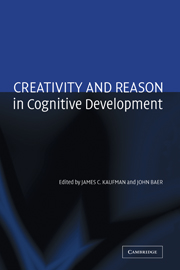Book contents
- Frontmatter
- Contents
- List of Contributors
- Acknowledgments
- Creativity and Reason in Cognitive Development
- Introduction
- COGNITIVE PERSPECTIVES
- DEVELOPMENTAL AND EDUCATIONAL PERSPECTIVES
- 12 Creativity in Young Children's Thought
- 13 A Young Artist's Story: Advancing Knowledge and the Development of Artistic Talent and Creativity in Children
- 14 Is It Reasonable to Be Creative?
- 15 Does Culture Always Matter: For Creativity, Yes, for Deductive Reasoning, No!
- 16 Higher Level Thinking in Gifted Education
- 17 The Relationship Among Schooling, Learning, and Creativity: “All Roads Lead to Creativity” or “You Can't Get There from Here”?
- 18 How Early School Experiences Impact Creativity: An Ecological Perspective
- 19 Conclusions
- Author Index
- Subject Index
- References
17 - The Relationship Among Schooling, Learning, and Creativity: “All Roads Lead to Creativity” or “You Can't Get There from Here”?
Published online by Cambridge University Press: 19 January 2010
- Frontmatter
- Contents
- List of Contributors
- Acknowledgments
- Creativity and Reason in Cognitive Development
- Introduction
- COGNITIVE PERSPECTIVES
- DEVELOPMENTAL AND EDUCATIONAL PERSPECTIVES
- 12 Creativity in Young Children's Thought
- 13 A Young Artist's Story: Advancing Knowledge and the Development of Artistic Talent and Creativity in Children
- 14 Is It Reasonable to Be Creative?
- 15 Does Culture Always Matter: For Creativity, Yes, for Deductive Reasoning, No!
- 16 Higher Level Thinking in Gifted Education
- 17 The Relationship Among Schooling, Learning, and Creativity: “All Roads Lead to Creativity” or “You Can't Get There from Here”?
- 18 How Early School Experiences Impact Creativity: An Ecological Perspective
- 19 Conclusions
- Author Index
- Subject Index
- References
Summary
Consider Sophia, an entering kindergarten student, who loves to draw. Equipped with a new box of 128 crayons, she eagerly anticipates the first opportunity to express herself in colored wax. Upon entering the classroom she darts to neat stacks of blank paper and starts to draw. The teacher quickly informs her that it is not “art time.” Confused, but compliant, she stops drawing. When “art time” does arrive, Sophia is again stopped because she started drawing without being told what to draw. Finally, the teacher informs the class that they will be drawing a picture of a tree with changing leaves. When Sophia eagerly starts drawing her tree, she is again stopped and instructed to wait for directions and guidance on how the tree should look. In a few short weeks, Sophia has developed a new understanding of what it means to draw: Wait patently for instructions from the teacher regarding what to draw and how to draw it. Consider the countless students whose favorite question, upon entering kindergarten, is “Why?” And how in a few short years the question “Why?” is replaced with “What do you want me to do and how do you want me to do it?”
The experience of schooling represented in the above scenario leaves little room for student imagination and curiosity. And there is evidence suggesting that such a scenario is a reality for students in our schools (Sternberg, 2003).
- Type
- Chapter
- Information
- Creativity and Reason in Cognitive Development , pp. 316 - 332Publisher: Cambridge University PressPrint publication year: 2006
References
- 54
- Cited by

